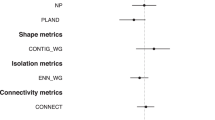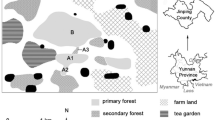Abstract
We report the results of a census of Indri indri conducted in Betampona Nature Reserve, a lowland rain forest in eastern Madagascar. In addition, we conducted a year-long study of the ranging behavior of 3 groups in the southwestern region of the reserve. We used 2 methods to calculate population density and home range size, and to provide minimum and maximum estimates. Population density of Indri indri ranged from 6.9–13.2 individuals/km2 in Betampona. Mean home range size is 27 ha. The values for population density and home range size are intermediate between values for Indri indri in selectively logged and undisturbed montane rain forest. Our results suggest a relationship between habitat disturbance, population density and home range size for the species. Recent increases in habitat disturbance appear to cause an increase in population density and a decrease in home range size. The results are consistent with ones for other folivorous primate populations. Further research on habitat requirements of Indri and availability in Betampona is necessary to investigate the possibility of translocating Indri from nearby forest fragments into Betampona.
Similar content being viewed by others
References
Abraham, J.-P., Benja, R., Randrianasolo, M., Ganzhorn, J. U., Jeannoda, V., and Leigh, E. G. (1996). Tree diversity on small plots in Madagascar: a preliminary review. Rev. Ecol. 51: 93–116.
Bailly, C., Benoit de Coignac, G., Malvos, C., Ningre, J. M., and Sarrailh, J.M (1974). Etude de l’influence du couvert naturel et des ses modifactions a Madagascar: experimentations en basins versants elementaires. Bois et Forets des Tropiques, supplement (4): 1–112.
Balko, E. A. (1998). A behaviorally plastic response to forest composition and logging disturbance by Varecia variegata variegata in Ranomafana National Park, Madagascar, PhD Dissertation, State University of New York, Syracuse, USA.
Britt, A. (1997). Environmental influences on the behavioural ecology of the black and white ruffed lemur (Varecia variegata variegata, Kerr, 1792), PhD Dissertation, University of Liverpool, U.K.
Britt, A. (2002). The current status of lemurs in the Sahivo and Antanamalaza classified forests, and the forest of Ambakaka, Toamasina province, Madagascar. Lemur News 7: 19–20.
Britt, A., Axel, A., and Young, R. (1999). Brief surveys of two classified forests in Toamasina Province, eastern Madagascar. Lemur News 4: 25–27.
Britt, A., Randriamandratonirina, N., Glasscock, K. D., and Iambana, B. R. (2002). Diet and feeding behaviour of Indri indri in a low-altitude rain forest. Folia Primatol. 73: 225–239.
Britt, A., Iambana, B. R., Welch, C. R., and Katz, A. S. (2003). Project Betampona: Re-stocking of Varecia variegata variegata into the Betampona Reserve. In Goodman, S. M. and Benstead, J. P. (eds.), The Natural History of Madagascar, The University of Chicago Press, Chicago and London, pp. 1545–1551.
Brockelman, W. Y., and Ali, R. (1987). Methods of surveying and sampling forest primate populations. In March, C. W. and Mittermeier, R. A. (eds.), Primate Conservation in the Rain Forest, Alan R. Liss, New York, pp. 23–62.
Brockelman, W. Y., and Srikosamatara, S. (1993). Estimation of density of gibbon groups by use of loud songs. Am. J. Primatol. 29: 93–108.
Chapman, C. A., and Chapman, L. J. (1999). Implications of small scale variation in ecological conditions for the diet and density of red colobus monkeys. Primates 40(1): 215–231.
Chapman, C. A., Chapman, L. J., Bjorndal, K. A., and Onderdonk, D. A. (2002). Application of protein-to-fiber ratios to predict colobine abundance on different spatial scales. Int. J. Primatol. 23(2): 283–310.
Chapman, C. A., Chapman, L. J., Rode, K. D., Hauck, E. M., and McDowell, L. R. (2003). Variation in the nutritional value of primate foods: Among trees, time periods, and areas. Int. J. Primatol. 24(2): 317–313.
Chivers, D. J. (1974). The siamang in Malaya: A field study of a primate in tropical rain forest (Contributions to Primatology), (Vol. 4). S. Karger, Basel, Switzerland.
Chivers, D. J., and Davies, G. (1979). Abundance of primates in the Krau Game Reserve, Peninsula Malaysia. In Marshall, A. G. (ed.), Transactions of the Sixth Aberdeen-Hull Symposium on Malesian Ecology. Department of Geography, University of Hull, Hull, U.K., pp. 9–32.
Cowlishaw, G., and Dunbar, R. (2000). Primate Conservation Biology. University of Chicago Press, Chicago,.
Davies, A. G. (1994). Colobine Monkeys: Their Ecology, Behavior and Evolution. In Davies, A. G. and Oates, J. F. (eds.), Cambridge University Press, Cambridge, pp. 285–310.
Dufils, J.-M. (2003). Remaining Forest Cover. In Goodman, S. M. and Benstead, J. P. (eds.), The Natural History of Madagascar, University of Chicago Press, Chicago and London, pp. 88–96.
Frankham, R., Ballou, J. D., and Briscoe, D. A. (2002). Introduction to Conservation Genetics. Cambridge University Press, New York.
Franklin, I. R. (1980). Evolutionary change in small populations. In Soule, M. E. and Wilcox, B. A. (eds.), Conservation biology: An evolutionary-ecological perspective, Sinauer, Sunderland, Massachusetts, pp. 135–149.
Ganzhorn, J. U. (1992). Leaf chemistry and the biomass of folivorous primates in tropical forests. Oecologia 91: 540–547.
Ganzhorn, J. U. (1995a). Low-level forest disturbance effects on primary production, leaf chemistry, and lemur populations. Ecology 76(7): 2084–2096.
Ganzhorn, J. U. (1995b). Causes for lemur population decline in degraded and secondary forests of the Morondava region. In Patterson, B. D., Goodman, S. M., and Sedlock, J. L. (eds.), Environmental Change in Madagascar, Chicago Field Museum of Natural/break History, Chicago, pp. 39.
Godfrey, L. R., and Jungers, W. L. (2003). Subfossil Lemurs. In Goodman, S. M. and Benstead, J. P. (eds.), The Natural History of Madagascar, University of Chicago Press, Chicago and London, pp. 1247–1252.
Green, G. M. G., and Sussman, R. W. (1990). Deforestation history of the eastern rain forests of Madagascar from satellite images. Science 248: 212–215.
Hayne, D. W. (1949). Calculation of size of home range. J. Mammol. 30: 1–17.
IUCN (2003). 2003 IUCN Red List of Threatened Species. IUCN 2003.
Johns, A. D. (1985). Differential detectability of primates between primary and selectively logged habitats and implications for population surveys. Am. J. Primatol. 8: 31–36.
Jungers, W. L., Godfrey, L. R., Simons, E. L., and Chatrath, P. S. (1995). Subfossil Indri indri from the Ankarana Massif of northern Madagascar. Am. J. Phys. Anthropol. 97(4):357–366.
Kappeler, M. (1984). The gibbon in Java. In Preuschoft, H., Chivers, D. J., Brockelman, W. Y., and Creel, N. (eds.), The Lesser Apes: Evolutionary and Behavioural Biology, Edinburgh University Press, Edinburgh, pp. 19–31.
Marsh, C. W., and Wilson, W. L. (1981). A survey of primates in peninsular Malaysian forests. Kuala Lumpur, Universiti Kebangsaan Malaysia.
Mittermeier, R. W., Tattersall, I., Konstant, W. R., Meyers, D. M., and Mast, R. B. (1994). Lemurs of Madagascar. Conservation International, Washington, D.C.
Oates, J. F., Whitesides, G. H., Davies, A. G., Waterman, P. G., Green, S. M., Dasilva, G. L., and Mole, S. (1990). Determinants of variation in tropical forest primate biomass: new evidence from West Africa. Ecology 71(1): 328–343.
Onderdonk, C., and Chapman, C. A. (2000). Coping with forest fragmentationL the primates of Kibale National Park, Uganda. Int. J. Primatol. 21: 587–611.
Petter, J.-J., Albignac, R., and Rumpler, Y. (1977). Mammiferes: lemuriens (Primates prosimiens). Faune de Madagascar No. 4. ORSTROM-CNRS, Paris.
Pollock, J. I. (1975). Field observations on Indri indri: A preliminary report. In Tattersall, I. and Sussman, R. W. (eds.), Lemur Biology, Plenum Press, New York, pp. 287–311.
Pollock, J. I. (1977). The ecology and sociology of feeding in Indri indri. In Cluttonbrock, T. H. (ed.), Primate Ecology: Studies of Feeding and Ranging Behaviour in Lemurs, Monkeys and Apes. Academic Press, London, pp. 37–69.
Pollock, J. I. (1979). Female dominance in Indri indri. Fol. Primatol. 31: 143–164.
Pollock, J. I. (1986). The song of the indris (Indri indri; Primates: Lemuroidea): Natural history, form, and function. Int. J. Primatol. 7: 225–264.
Powzyk, J. A. (1997). The Socio-Ecology of Two Sympatric Indriids: Propithecus diadema diadema and Indri indri, a Comparison of Feeding Strategies and Their Possible Repercussions on Species-Specific Behaviors. PhD Dissertation, Duke University.
Powzyk, J., and Thalmann, U. Indri indri, Indri. In Goodman, S. M. and Benstead, J. P. (eds.), The Natural History of Madagascar, University of Chicago Press, Chicago and London, pp. 1342–1345.
Razokiny (1985). Monographie de la Reserve naturelle de Betampona. Unpublished report.
Skorupa, J. P. (1986). Responses of rain-forest primates to selective logging in Kibale Forest, Uganda: a summary report. In Benirschke, K. (ed.), Primates, the Road to Self-Sustaining Populations, Springer Verlag, New York, pp. 57–70.
Stanford, C. B. (2002). Avoiding predators: expectations and evidence in primate anitpredator behavior. Int. J. Primatol. 23(4): 741–757.
Struhsaker, T. T. (1975). The Red Colobus Monkey. University of Chicago Press, Chicago.
Sutherland, W. J. (1996). Ecological Census Techniques: A Handbook. Cambridge University Press, U.K.
Tattersall, I. (1982). The Primates of Madagascar. Columbia University Press, New York.
Terborgh, J., and Winter, B. (1980). Some causes of extinction. In Soule, M. E. and Wilcox, B. A. (eds.), Conservation Biology, Sinauer Associates, Sunderland, MA, pp. 119–133.
Waterman, P. G., Ross, J. A.M., Bennett, E. L., and Davies, A. G. (1988). A comparison of the floristics and leaf chemistry of the tree flora in two Malaysian rain forests and the influence of leaf chemistry on populations of colobine monkeys in the Old World. Biol. J. Linn. Soc. 34(1): 1–32.
Welch, C., and Katz, A. (1992). Survey and census work on lemurs in the natural reserve of Betampona in eastern Madagascar with a view to restocking. DODO 28: 45–58.
Wilson, C. C., and Wilson, W. L. (1975). The influence of selective logging on primates and some other animals in East Kalimantan. Fol. Primatol. 23: 245–274.
Author information
Authors and Affiliations
Corresponding author
Rights and permissions
About this article
Cite this article
Glessner, K.D.G., Britt, A. Population Density and Home Range Size of Indri indri in a Protected Low Altitude Rain Forest. Int J Primatol 26, 855–872 (2005). https://doi.org/10.1007/s10764-005-5326-2
Received:
Revised:
Accepted:
Issue Date:
DOI: https://doi.org/10.1007/s10764-005-5326-2




